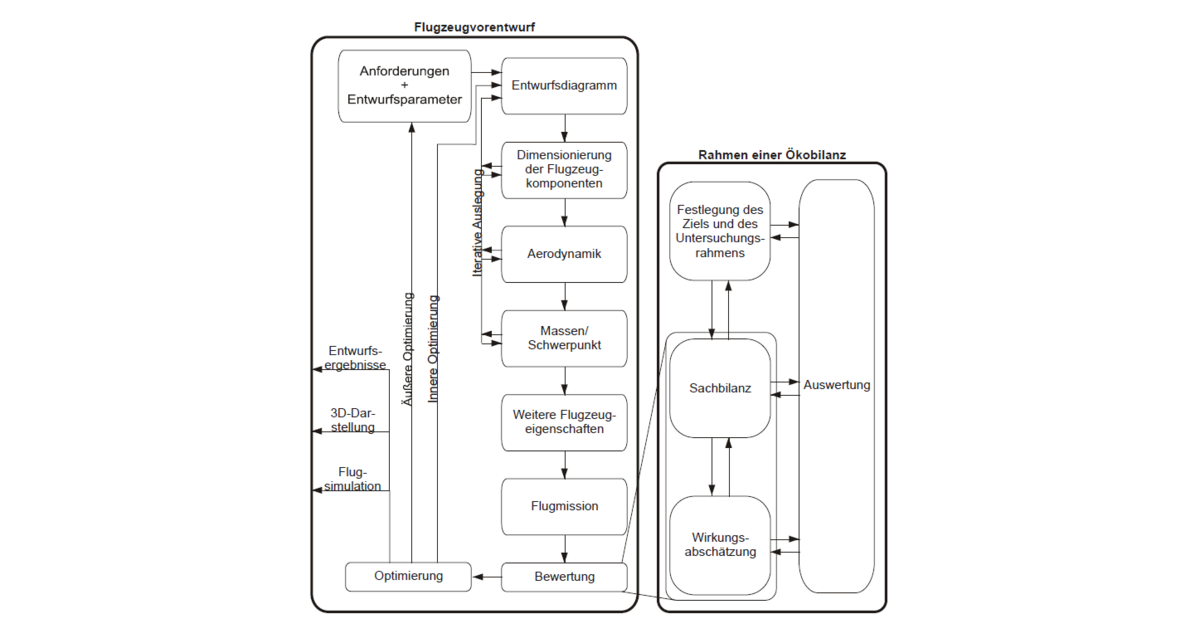

 |
 |
Abstract
Method for Life Cycle Assessment in Conceptual Aircraft Design
In this thesis, a methodology for life cycle assessment in conceptual aircraft design is being developed. Using this methodology, the environmental impact of the designed aircraft can be calculated. Additionally, the driving in- and outputs, processes, life cycle phases, impact categories and design parameters for the environmental impact of aircraft can be identified. A turboprop aircraft serves as application example for the methodology. It is being optimized for minimum environmental impact and the results are being compared to those of a reference aircraft. Additionally, the methodology is applied to future aircraft concepts, and their environmental impact is compared to that of the reference aircraft as well. The investigation of the turboprop aircraft shows that there is generally a high potential for reducing environmental impact. The reduction of fuel consumption and an adaptation of flight altitude are identified as decisive factors. The environmental impact of the investigated future concepts is tending to shift from flight to the production of the respective energy sources. In the production process, the share of electric energy from renewable energy sources should be as high as possible to achieve minimum environmental impact. The integration of a life cycle assessment methodology into conceptual aircraft design allows to analyze and influence the environmental impact of future aircraft early in the design process.
| Download full text: |
 TextJohanning.pdf
Size:
4.9M TextJohanning.pdf
Size:
4.9M |
| Date: | 2017-05-21 |
| Type of work: | Dissertation |
| Advisor: | Dieter Scholz, HAW Hamburg |
| Advisor: | Mirko Hornung, Technische Universität München |
| Examiner: | Florian Holzapfel (Vorsitzender), Technische Universität München |
| Examiner: | Mirko Hornung, Technische Universität München |
| Examiner: | Dieter Scholz, HAW Hamburg |
| Public Defence: | 2016-03-24, Technische Universität München, Fakultät für Maschinenwesen, Boltzmannstraße 15, D-85748 Garching |
| Published by: | Aircraft Design and Systems Group (AERO), Department of Automotive and Aeronautical Engineering, Hamburg University of Applied Sciences |
| Published by: | München, Germany: Verlag Dr. Hut |
| ISBN (print): | 978-3-8439-3179-3 |
| Project: | http://Airport2030.ProfScholz.de  |
This work is part of: |
Digital Library - Projects & Theses - Prof. Dr. Scholz ---
http://library.ProfScholz.de
 |
| PERSISTENT IDENTIFIER: | |
| URN: | https://nbn-resolving.org/urn:nbn:de:gbv:18302-aero2017-05-21.01 (to reach this page) |
| URN: | https://nbn-resolving.org/urn:nbn:de:101:1-2013101111508 |
| URN: | https://nbn-resolving.org/urn:nbn:de:bvb:91-diss-20170510-1295244-1-0 |
| DOI: | https://doi.org/10.15488/19276 |
| DOI: | https://doi.org/10.48441/4427.2689 |
| ARK: | https://n2t.net/ark:/13960/s21xxmvpm0k |
| HANDLE: | https://hdl.handle.net/20.500.12738/3242 |
| Associated research data: | https://doi.org/10.7910/DVN/ASOLZ4 (Program) |
| https://doi.org/10.13140/RG.2.1.1531.0485 | |
| URLs registered with URN: | Show all links associated with this text! |
| CATALOG ENTRY: | |
| DNB: | Check inclusion of this title in German National Library! |
| WorldCat: | Check inclusion of this title in WorldCat! |
| DataCite: | Check inclusion of this title in DataCite! |
| Google Scholar: | Check inclusion of this title in Google Scholar! |
| OpenAIRE: | Check inclusion of this title in OpenAIRE! |
| Semantic Scholar: | Check inclusion of this title in Semantic Scholar! |
| BASE: | Check inclusion of this title in BASE! |
| CORE: | Check inclusion of this title in CORE! |
| Google: | Check inclusion of this title in Google! |
| Keywords, German (GND): | Luftfahrt, Passagierflugzeug, Turboprop, Lebenszyklusanalyse |
| Keywords, English (LCSH): | Aeronautics, Airplanes, Turboprop transports, Environmental impact analysis |
| Keywords, free: | Luftfahrzeug, Propeller-Turbinen-Luftstrahltriebwerk, Life-cycle-assessment, LCA, Kraftstoffverbrauch, Flughöhe, Energieträger, Elektrische Energie, Erneuerbare Energien, Sensitivitätsanalyse, Pareto-Optimierung, Flugzeugvorentwurf, Flugzeugkonzept, Turbopropflugzeug, Referenzflugzeug, Umweltwirkung, Ökobilanzierung, Lebenszyklusphase, Wirkungskategorie, Sachbilanz, Wirkungsabschätzung, Ökobilanzergebnisse, Unsicherheitsanalyse, Robustheitsanalyse, Design, Mathematical optimization, Airplanes--Fuel consumption, Product life cycle, Renewable energy sources, life cycle assessment, conceptual aircraft design, impact category, design parameter, reference, aircraft, concept, energy source, production process, electric energy |
| DDC: | 629.13, 629.133340423, 333.714, 658.4083 |
| RVK: | ZO 7600 |
© This work is protected by copyright
Any further request may be directed to:
Prof. Dr.-Ing. Dieter Scholz, MSME
E-Mail see: http://www.ProfScholz.de
VISIBILITY: (more)
Quote this text:
| ISO 690: JOHANNING, Andreas, 2017. Methodik zur Ökobilanzierung im Flugzeugvorentwurf. Dissertation. Hamburg University of Applied Sciences, Aircraft Design and Systems Group (AERO). Available from: https://nbn-resolving.org/urn:nbn:de:gbv:18302-aero2017-05-21.01 [viewed YYYY-MM-DD]. |
Major results / graphical abstract:


 Prof. Dr. Scholz
Prof. Dr. Scholz
 Aircraft Design and Systems Group (AERO)
Aircraft Design and Systems Group (AERO)
 Aeronautical Engineering
Aeronautical Engineering
 Department of Automotive and Aeronautical Engineering
Department of Automotive and Aeronautical Engineering
 Faculty of Engineering and Computer Science
Faculty of Engineering and Computer Science
 Hamburg University of Applied Sciences
Hamburg University of Applied Sciences